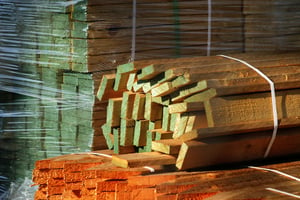If treated wood is part of the waste your company generates, it’s important to get a plan in place now for its disposal.
Effective Jan. 1, 2021, California will require that all treated wood be managed under hazardous waste guidelines. That means if your facility discards treated wood as part of your normal waste disposal process, you must now follow hazardous waste laws.
According to the Department of Toxic Substances Control (DTSC), the current statute and regulations that allow treated wood waste to be handled with alternative management standards are due to expire at the end of December. Beginning Jan. 1, all treated wood waste managed in California that is not exempted by HSC 25143.1.5 as utility generated, “will have to be stored and manifested as hazardous waste and transported to class 1 hazardous waste landfills for disposal.”
What Is Treated Wood Waste?
 Treated wood waste is old wood that has been treated with chemical preservatives. Chemicals are often used to protect the wood from being destroyed by insects or other issues like fungal decay. Treated wood is all arounds us…from fence posts to decking, utility poles, piers, railroad ties and landscape timbers.
Treated wood waste is old wood that has been treated with chemical preservatives. Chemicals are often used to protect the wood from being destroyed by insects or other issues like fungal decay. Treated wood is all arounds us…from fence posts to decking, utility poles, piers, railroad ties and landscape timbers.
To treat wood, manufacturers use a variety of hazardous chemicals that include arsenic, creosote, chromium and pentachlorophenol. These chemicals are known to be carcinogenic or toxic. Individuals and the environment can be exposed to these chemicals through the burning of these materials or simply through touching them.
What Does This Mean For Generators?
These new regulations that are about to go into place mean that you will likely not be able to drop off your treated wood waste at the same landfill that you used prior to January 1.
Only Class 1 landfills are authorized to accept hazardous waste in California. Workers at Class II and Class III landfills have been instructed to no longer accept any treated wood waste.
It’s important to start forming a plan now if you must change where you dispose of your treated wood. While it may be simply a matter of picking a new location, it is important to check requirements for drop-off.
Many hazardous waste facilities have volume restrictions and costs associated with dropping off waste. Restrictions may also vary between residents, small businesses and large businesses.
Are There Disposal Services Available?
 Yes. In fact, working with a hazardous waste disposal company can make adapting your waste management plan to these new regulations much easier.
Yes. In fact, working with a hazardous waste disposal company can make adapting your waste management plan to these new regulations much easier.
A certified hazardous waste disposal company will safely remove your waste and transport it to the appropriate disposal facility. A quality vendor will be able to:
- Identify wastes through sampling and testing them, as well as be able to confirm whether the wood in your possession is treated or not
- Transport the wastes to recycling and disposal sites
- Prepare labels, manifests and other paperwork
- Offer prompt pickups
- Address any cost concerns that you have
- Assist you with properly packaging the treated wood waste so that you can avoid fines and save money
Now that the disposal of treated wood must follow hazardous waste guidelines, one additional benefit to working with a hazardous waste disposal company is that you can ensure all cradle to grave requirements are met.
If your facility needs to dispose of treated wood, you are held responsible for its improper off-site transportation and disposal. If you send an employee to drop off treated wood at a facility, and that treated wood never makes it to the appropriate landfill for one reason or another, your company can be held liable.
When it comes to hazardous waste, it’s best to leave it up to professional disposal companies that can ensure all cradle to grave requirements are legally met.
How Do I Choose Disposal Services?
Choosing the right hazardous waste disposal company that will properly dispose of your treated wood waste should be a carefully considered process, taking in account reliability, reputation and legality.
Scrolling through an online directory or doing a general Google search will likely yield many results. To narrow your choices down, look for a disposal company that:
- Has the ability to transport treated wood waste
- Can identify whether your wood is considered hazardous, if needed
- Is registered using the California Department of Toxic Substances Control’s Registered Hazardous Waste Transporter Database
- Can provide you with documentation of compliance history, insurance coverage and qualifications
- Can remove your treated wood according to your timeline
- Will provide a list of references (this can further help you narrow down a few top choices)
One final question to ask when narrowing down your options is whether the disposal company will offer a walk-through program. This can be especially beneficial now with these new regulations in place because a disposal company can evaluate your waste storage and help you set up a disposal plan if your company regularly uses treated wood.
California has some of the strictest hazardous waste regulations in the country, and it’s about to get even more strict after treated wood waste is added to the list of materials that must be properly disposed of according to hazardous waste guidelines. Finding a hazardous waste disposal company that can ensure you meet all regulations is essential for reducing your liability.

Comment